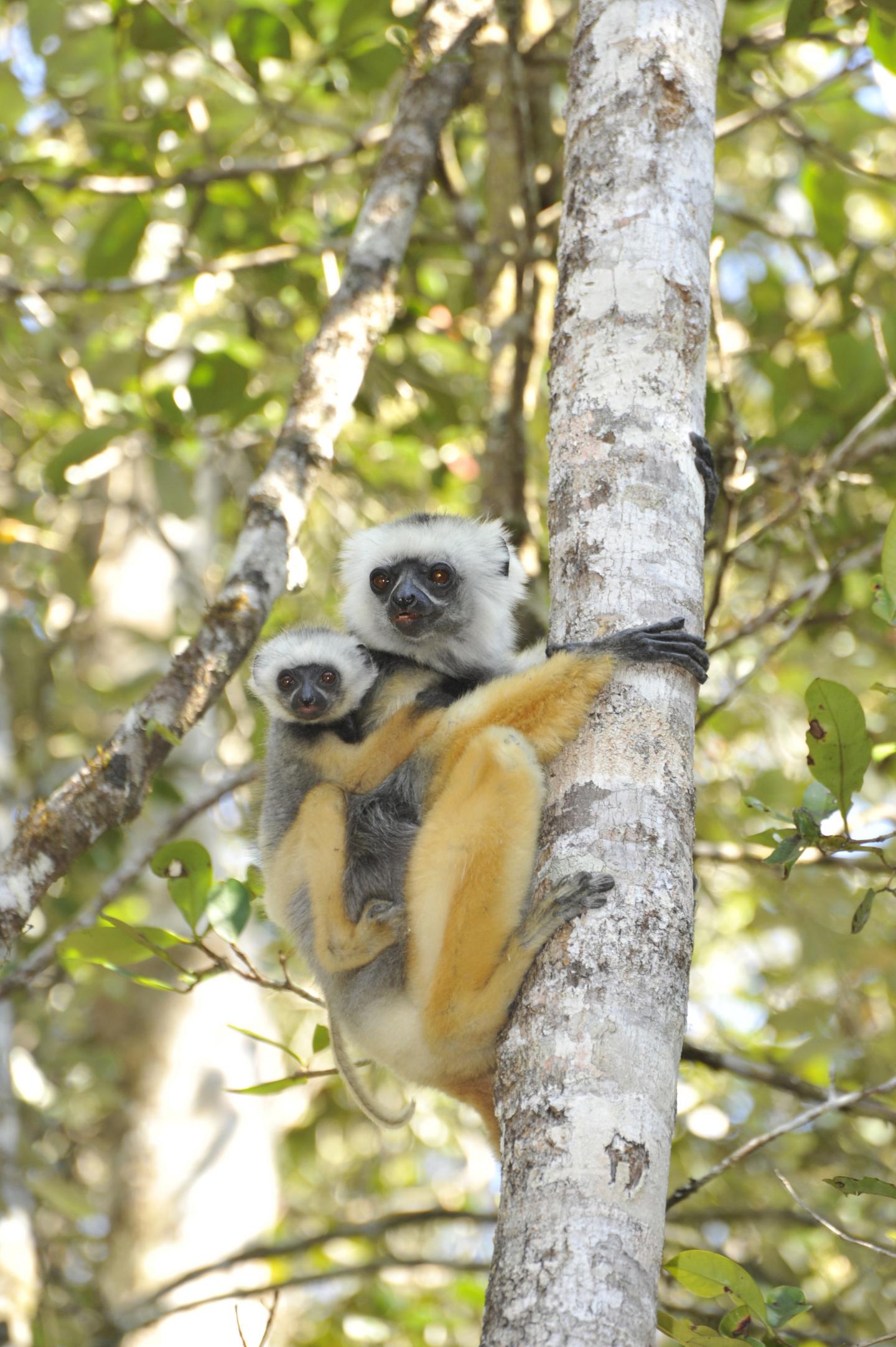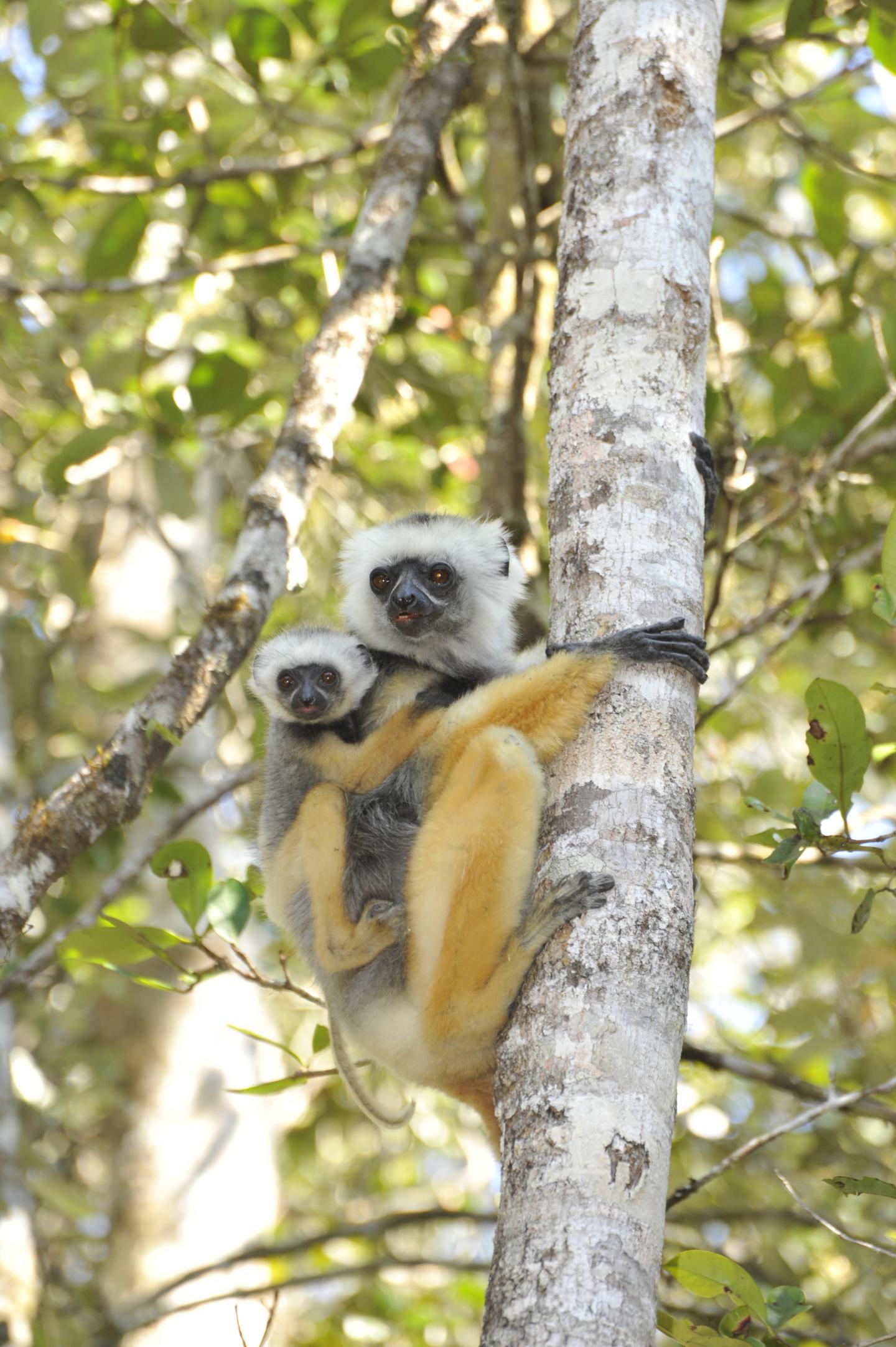
IMAGE: A diademed sifaka lemur perches on a tree trunk with her infant in Andasibe-Mantadia National Park, Madagascar. Researchers are using RNA sequencing to identify emerging infectious diseases in lemurs that…
Credit: David Haring, Duke Lemur Center
DURHAM, N.C. — Advances in genetic sequencing are uncovering emerging diseases in wildlife that other diagnostic tests can't detect.
In a study led by Duke University, researchers used a technique called whole-transcriptome sequencing to screen for blood-borne diseases in wild lemurs, distant primate cousins to humans.
The animals were found to carry several strains or species of parasites similar to those that cause Lyme disease and other infections in humans.
This is the first time these parasites have been reported in lemurs or in Madagascar, the only place on Earth where lemurs live in the wild outside of zoos and sanctuaries, the researchers report in the Jan. 27, 2016 issue of Biology Letters.
The approach could pave the way for earlier, more accurate detection of future outbreaks of zoonotic diseases that move between animals and people.
"We can detect pathogens we might not expect and be better prepared to deal with them," said co-author Anne Yoder, director of the Duke Lemur Center.
In 2012, Duke Lemur Center veterinarian Cathy Williams and colleagues started performing physical exams on lemurs in the rainforests surrounding a mine site in eastern Madagascar to help monitor the impacts of such activities on lemur health.
"Lemur populations are becoming increasingly small and fragmented because of human activities like mining, logging and clearing forests to make way for cattle grazing and rice paddies," Williams said. "If an infectious disease wipes out a lemur population it could be a huge blow to the species."
Researchers took small amounts of blood and tested them for evidence of exposure to known viruses and pathogens, but nothing turned up.
The problem is that standard diagnostic tests tend to target known pathogens, Williams said. You can check for antibodies to certain viruses, or look for specific snippets of genetic material in an animal's blood, "but you have to know what you're looking for."
The end result is that new or exotic diseases often go undetected.
And with hundreds of thousands of viral and bacterial species that lemurs and other mammals harbor still awaiting discovery, "we could be looking for anything," Williams said.
To cast a wider net they tried a new approach.
Lead author Peter Larsen, senior research scientist at Duke, analyzed blood samples from six lemurs in two species, the indri and the diademed sifaka, both of which are considered critically endangered by the International Union for Conservation of Nature (IUCN).
With advances in high-throughput sequencing, the ability to read genetic code rapidly, Larsen was able to look at all the gene readouts, or RNA transcripts, that were present in each animal — an alphabet soup containing billions of nucleotide bases.
The team found more than just lemur RNA in the animals' blood. Using computer algorithms that compared the genetic material to sequences already catalogued in existing databases, they discovered several new types of parasites that had never been reported in lemurs.
These included a new form of the protozoa responsible for babesiosis, a disease spread by bites from infected ticks, and a new kind of Borrelia closely related to the bacterium that causes Lyme disease. They also found the first known case in Madagascar of a bacterium called Candidatus Neoehrlichia, which can be deadly in humans.
Further analyses revealed that the new types of Babesia and Borrelia they found didn't begin in lemurs, but were likely introduced to Madagascar in infected pets and livestock such as cattle and then spilled over to lemurs.
The researchers don't yet know if the new parasites are actually dangerous to lemurs. But they caution that what is infecting lemurs could potentially infect people, too. Human health officials and veterinarians in Madagascar may want to consider screening their patients to see if any test positive for the same parasites, the researchers say.
The majority of emerging infectious diseases that affect humans, including recent outbreaks of SARS, Ebola and bird flu, are zoonotic — they can spread among wildlife, domestic animals and humans.
"Next-generation sequencing will be an important tool to identify emerging pathogens, particularly vector-borne diseases," said Barbara Qurollo, a research assistant professor at the N.C. State College of Veterinary Medicine who was not affiliated with the study.
"A clinician cannot treat an infection that he or she does not know exists," said veterinarian and infectious diseases researcher Edward Breitschwerdt, also of the N.C. State College of Veterinary Medicine. "The kindest form of therapy is an accurate diagnosis."
###
Other authors include Corinne Hayes of Duke, Randall Junge of the Columbus Zoo and Aquarium, Josia Razafindramanana of the Groupe d'Etude et de Recherche sur les Primates de Madagascar, Vanessa Mass of VMC Environment Inc. and Hajanirina Rakotondrainibe of Ambatovy Minerals S.A.
This research was supported by Ambatovy Minerals S.A. and the Duke Lemur Center.
CITATION: "Blood Transcriptomes Reveal Novel Parasitic Zoonoses Circulating in Madagascar's Lemurs," Peter Larsen et al. Biology Letters, Jan. 27, 2016.
DOI: http://dx.doi.org/10.1098/rsbl.2015.0829
Media Contact
Robin Ann Smith
[email protected]
919-681-8057
@DukeU
http://www.duke.edu





